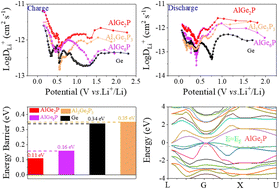Ternary AlGexP alloy compounds for high capacity and rate capability of lithium-ion battery anodes†
Abstract
Despite the high volumetric capacity of Ge-based anodes, their practical applications are still limited by low cycling stability and rate performance. To resolve these challenges, herein, we simultaneously incorporate both Al and P into Ge to synthesize AlGexP (x = 6, 2, 2/3) series materials through a facile mechanical ball milling method. Experiments and theoretical calculations confirm that AlGe2P provides the fastest electronic conductivity and Li-ion diffusion capability, thus providing the best Li-storage performance among AlGexP (x = 6, 2, 2/3) series materials. As verified by ex situ characterization, AlGe2P features a reversible Li-storage mechanism arising from the first intercalation stage followed by conversion reactions, where the electronically conducting Li15GeP3, Li4.4Ge, and LiAl and Li-ion conducting Li3P, Li4.4Ge and LiAl are simultaneously produced, ensuring fast charge storage kinetics upon cycling. Accordingly, the AlGe2P/C composite presents a long-term cycling stability of retaining 867 mA h g−1 after 800 cycles at 2000 mA g−1, and a high-rate capacity of 454 mA h g−1 even at 20 000 mA g−1, thus holding promise for real world applications. Broadly, the ternary all-lithium-reactive Ge-based compounds have great application potential in the energy storage field due to their intriguing physiochemical properties.



 Please wait while we load your content...
Please wait while we load your content...